Genesis of Metal Sulfides and Its Significance on Graphite Mineralization in the Huangyangshan Graphite Deposit, East Junggar, Xinjiang Province, China
Abstract
:1. Introduction
2. Geological Background and Deposit Geology
2.1. Regional Geology
2.2. Huangyangshan Complex
2.3. Characteristics of Graphite Mineralization
3. Samples and Analytical Methods
3.1. Sample Descriptions
3.2. Analytical Methods
4. Analytical Results
4.1. Metal Sulfides in Orbicular Ores
4.2. X-ray Micro-CT Scanning and SEM Analysis
4.3. In Situ LA-ICP-MS Trace Element of Sulfides
5. Discussion
5.1. Mineral Characteristics of Graphite Ores
5.2. The Origin of Sulfide
5.2.1. Pyrrhotite
5.2.2. Chalcopyrite
5.3. Implications of Metal Sulfides for Graphite Mineralization
6. Conclusions
Author Contributions
Funding
Data Availability Statement
Acknowledgments
Conflicts of Interest
References
- Zhang, X.L.; Fan, W.J.; Li, Z.W.; Chen, Z.G.; Chen, J.Y. The discovery of a superlarge magmatic graphite deposit in Huangyangshan area, Qitai County, Xinjiang. Geol. China 2017, 44, 1033–1034, (In Chinese with English Abstract). [Google Scholar]
- Bai, J.K.; Chen, J.L.; Peng, S.X. Geochronology and geochemistry of ore-bearing intrusions from Huangyangshan magmatic hydrothermal graphite deposit in Qitai County, Xinjiang. Acta Petrol. Sin. 2018, 34, 2327–2340, (In Chinese with English Abstract). [Google Scholar]
- Yang, G.X.; Li, Y.J.; Wu, H.E.; Zhong, X.; Yang, B.K.; Yang, C.X.; Yan, J.; Si, G.H. Geochronological and geochemical constrains on petrogenesis of the Huangyangshan A-type granite from the East Junggar, Xinjiang, NW China. J. Asian Earth Sci. 2011, 40, 722–736. [Google Scholar] [CrossRef]
- Sun, X.H.; Ren, Y.S.; Sun, Z.J.; Wang, C.Y.; Li, Z.W. Geochronology and geochemical properties of the large-scale graphite mineralization associated with the Huangyangshan alkaline pluton, Eastern Junggar, Xinjiang, NW China. Geochemistry 2021, 81, 125820. [Google Scholar] [CrossRef]
- Mo, R.J.; Liu, S.B.; Huang, C.R. Geology of Graphite Deposits in China; China Architecture & Building Press: Beijing, China, 1989; pp. 66–85. (In Chinese) [Google Scholar]
- Zhang, G.X.; Hu, A.Q.; Zhang, H.B.; Zhang, Q.F.; Shen, Y.L. Caebon isotopic evidence for the origin of the spherical graphite in a granite-hosted graphite deposit, Sujiquan, Xinjiang, China. Geochimica 1996, 25, 379–386, (In Chinese with English Abstract). [Google Scholar]
- Yang, G.X.; Li, Y.J.; Wu, H.E.; Si, G.H.; Zhang, Y.Z.; Jin, Z. A tentative discussion on the genesis of Huangyangshan granite body in Kalamaili Orogen, East Junggar. Acta Geosci. Sin. 2010, 31, 170–182, (In Chinese with English Abstract). [Google Scholar]
- Li, C.; Wang, D.H.; Zhao, H.; Pei, H.X.; Li, X.W.; Zhou, L.M.; Du, A.D.; Qu, W.J. Minerogenetic regularity of graphite deposits in China. Miner. Deposit. 2015, 34, 1223–1236, (In Chinese with English Abstract). [Google Scholar]
- Bai, J.K.; Chen, J.L.; Peng, S.X. Charcteristics and metallogeny regulation of graphite resources in Xinjiang. Acta Geol. Sin. 2017, 91, 2828–2840, (In Chinese with English Abstract). [Google Scholar]
- Ai, J.; Lu, X.B.; Li, Z.W.; Wu, Y.L. Genesis of the graphite orbicules in the Huangyangshan graphite deposit, Xinjiang, China: Evidence from geochemical, isotopic and fluid inclusion data. Ore Geol. Rev. 2020, 122, 103505. [Google Scholar] [CrossRef]
- Ai, J. Metallogenic Mechanism and Model of Huangyangshan Magmatic Fluid-Type Graphite Deposit in Xinjiang. Ph.D. Thesis, China University of Geosciences (Wuhan), Wuhan, China, 2020. (In Chinese with English Abstract). [Google Scholar]
- Sun, X.H.; Ren, Y.S.; Sun, Z.J.; Wang, C.Y. Characteristics, ore sources and genesis of Huangyangshan graphite deposit in Qitai County, Xinjiang. Acta Petrol. Sin. 2021, 37, 1867–1882, (In Chinese with English Abstract). [Google Scholar]
- Li, J.Y.; Xiao, X.C.; Tang, Y.Q.; Zhao, M. Main characteristics of late Paleozoic plate tectonics in the southern part of east Junggar, Xinjiang. Geol. Rev. 1986, 36, 305–316, (In Chinese with English abstract). [Google Scholar]
- Li, J.Y.; Yang, T.N.; Li, Y.P.; Zhu, Z.X. Geological features of the Karamaili faulting belt, eastern Junggar region, Xinjiang, China and its constraints on the reconstruction of Late Paleozoic ocean-continental frame work of the Central Asian region. Geol. Bull. China 2009, 28, 1817–1826, (In Chinese with English abstract). [Google Scholar]
- Long, X.P.; Yuan, C.; Sun, M.; Safonova, I.; Xiao, W.J.; Wang, Y.J. Geochemistry and U–Pb detrital zircon dating of Paleozoic graywackes in East Junggar, NW China: Insights into subduction–accretion processes in the southern Central Asian Orogenic Belt. Gondwana Res. 2012, 21, 637–653. [Google Scholar] [CrossRef]
- Han, Y.G.; Zhao, G.C. Final amalgamation of the Tianshan and Junggar orogenic collage in the southwestern Central Asian Orogenic Belt: Constraints on the closure of the Paleo-Asian Ocean. Earth-Sci. Rev. 2017, 186, 129–152. [Google Scholar] [CrossRef]
- Xiao, W.J.; Han, C.M.; Yuan, C.; Sun, M.; Lin, S.; Chen, H.; Li, Z.; Li, J.; Sun, S. Middle Cambrian to Permian subduction-related accretionary orogenesis of Northern Xinjiang, NW China: Implications for the tectonic evolution of central Asia. J. Asian Earth Sci. 2008, 32, 102–117. [Google Scholar] [CrossRef]
- Xiao, W.J.; Windley, B.; Sun, S.; Li, J.L.; Huang, B.C.; Han, C.M.; Yuan, C.; Sun, M.; Chen, H.L. A tale of amalgamation of three Permo-Triassic collage systems in Central Asia: Oroclines, sutures, and terminal accretion. Annu. Rev. Earth Planet. Sci. 2015, 43, 477–507. [Google Scholar] [CrossRef] [Green Version]
- Yuan, C.; Sun, M.; Wilde, S.; Xiao, W.J.; Xu, Y.G.; Long, X.P.; Zhao, G.C. Postcollisional plutons in the Balikun area, East Chinese Tianshan: Evolving magmatism in response to extension and slab break-off. Lithos 2010, 119, 269–288. [Google Scholar] [CrossRef]
- Zhang, Y.Y.; Pe-Piper, G.; Piper, D.J.W.; Guo, Z.J. Early Carboniferous collision of the Kalamaili orogenic belt, North Xinjiang, and its implications: Evidence from molasse deposits. Geol. Soc. Am. Bull. 2013, 125, 932–944. [Google Scholar] [CrossRef]
- Xu, Q.Q.; Zhao, L.; Niu, B.G.; Zheng, R.G.; Yang, Y.Q.; Liu, J.H. Early Paleozoic arc magmatism in the Kalamaili orogenic belt, Northern Xinjiang, NW China: Implications for the tectonic evolution of the East Junggar terrane. J. Asian Earth Sci. 2020, 194, 104072. [Google Scholar] [CrossRef]
- Li, Y.P.; Li, J.Y.; Sun, G.H.; Zhu, Z.X.; Yang, Z.Q. Basement of Junggar basin: Evidence from detrial zircons in sandstone of previous Devonian Kalamaili formation. Acta Petrol. Sin. 2007, 23, 1577–1590, (In Chinese with English abstract). [Google Scholar]
- Guo, Z.J. A review on the Paleozoic tectonic evolution of northern Xinjiang and a discussion on the important role of geological maps in tectonic study. Geol. Bull. China 2012, 31, 1054–1060, (In Chinese with English abstract). [Google Scholar]
- Cai, X.F.; Fan, G.M.; Liao, Q.A.; Wang, F.M.; Wu, L.Y. Features of lower carboniferous intra-plate sedimentation in the Kalamai region, East Junggar, Xinjiang, China. Bull. Miner. Petrol. Geochem. 2015, 34, 1287–1302, (In Chinese with English abstract). [Google Scholar]
- Lin, J.F.; Yu, H.X.; Yu, X.Q.; Di, Y.J.; Tian, J.T. Zircon SHRIMP U–Pb dating and geological implication of the Sabei alkali-rich granite from Eastern Junggar of Xinjiang, NW China. Acta Petrol. Sin. 2007, 23, 1876–1884, (In Chinese with English abstract). [Google Scholar]
- Su, Y.P.; Tang, H.F.; Cong, F. Zircon U–Pb age and petrogenesis of the Huangyangshan alkaline granite body in East Junggar, Xinjiang. Acta Miner. Sin. 2008, 28, 117–126, (In Chinese with English abstract). [Google Scholar]
- Han, B.F.; Ji, J.Q.; Song, B.; Chen, L.H.; Zhang, L. Late Paleozoic vertical growth of continental crust around the Junggar Basin, Xinjiang, China (Part I): Timing of postcollisional plutonism. Acta Petrol. Sin. 2006, 22, 1077–1086, (In Chinese with English abstract). [Google Scholar]
- Tang, H.F.; Qu, W.J.; Su, Y.P.; Hou, G.S.; Du, A.D.; Cong, F. Genetic connection of Sareshike tin deposit with the alkaline A-type granites of Sabei body in Xinjiang: Constraint from isotopic ages. Acta Petrol. Sin. 2007, 23, 1989–1997, (In Chinese with English abstract). [Google Scholar]
- Xu, B. Research on Tectonic-Magma ore-Controlling Regularity and Prospecting Forecasting of Gold Metallogenic Belt in Kalamaili Area, Xinjiang. Ph.D. Thesis, China University of Geosciences (Beijing), Beijing, China, 2007. [Google Scholar]
- Gan, L.; Tang, H.F.; Han, Y.J. Geochronology and geochemical characteristics of the Yemaquan granitic pluton in East Junggar, Xinjiang. Acta Petrol. Sin. 2010, 26, 2374–2388, (In Chinese with English abstract). [Google Scholar]
- Chen, G.Y.; Sun, D.S.; Yin, H.A. Genetic Mineralogy and Prospecting Mineralogy; Chongqing Publishing Group: Chongqing, China, 1987. (In Chinese) [Google Scholar]
- Li, S.R. Crystallography and Mineralogy; Geology Press: Beijing, China, 2008. (In Chinese) [Google Scholar]
- Zhang, Z.L.; Geng, X.X.; Yang, F.Q.; Zhang, Z.X.; Xu, Q.F. Gold enrichment and the Au–Te association in the Huangtan Au–Cu–Zn volcanogenic massive sulfide deposit, Kalatag, East Tianshan, China: An in-situ LA–ICP–MS analysis. Ore Geol. Rev. 2021, 138, 104407. [Google Scholar] [CrossRef]
- Yang, Z.K.; Yang, Y.; Zhang, Z.K.; Lin, B.; He, J.; Zhang, Z.B.; Gao, F.T.; Tang, X.Q.; Tang, P.; Qi, J.; et al. Geochemistry of pyrrhotite in the Jiama deposit, Tibet and its relationship with gold enrichment and precipitation. Geol. China 2020, 49, 1198–1213, (In Chinese with English abstract). [Google Scholar]
- Loftus-Hills, G.; Solomon, M. Cobalt, Nickel and selenium in sulphides as indicators of ore genesis. Miner. Depos. 1967, 2, 228–242. [Google Scholar] [CrossRef]
- Bralia, A.; Sabatini, G.; Troja, F. A revaluation of the Co/Ni ratio in pyrite as geochemical tool in ore genesis problems. Miner. Depos. 1979, 14, 353–374. [Google Scholar] [CrossRef]
- Chen, D.F. Characteristics of metallic minerals in some copper-nickel sulfide deposits of China. Acta Petrol. Miner. 1995, 14, 345–354, (In Chinese with English abstract). [Google Scholar]
- Liu, Y.J. Elemental Geochemistry; Geology Press: Beijing, China, 1984; pp. 1–548. (In Chinese) [Google Scholar]
- Zhao, Z.H. Principle of Trace Element Geochemistry; Science Press: Beijing, China, 1997; pp. 1–238. (In Chinese) [Google Scholar]
- Steadman, J.A.; Large, R.R. Synsedimentary, diagenetic, and metamorphic pyrite, pyrrhotite, and marcasite at the Homestake BIF-hosted gold deposit, South Dakota, USA: Insights on Au-As ore genesis from textural and LA-ICP-MS trace element studies. Econ. Geol. 2016, 111, 1731–1752. [Google Scholar] [CrossRef]
- Liu, W.S.; Zhao, R.Y.; Zhang, X.; Jiang, J.C.; Chen, Y.C.; Wang, D.H.; Ying, L.J.; Liu, Z.Q. The EPMA and LA-ICP-MS in situ geochemical features of pyrrhotite and pyrite in Dabaoshan Cu-polymetallic deposit, North Guangdong province, and their constraint on genetic mechanism. Acta Geosci. Sin. 2019, 40, 291–306, (in Chinese with English abstract). [Google Scholar]
- Bajwah, Z.U.; Seccombe, P.K.; Offler, R. Trace element distribution, Co:Ni ratios and genesis of the Big Cadia iron-copper deposit, New South Wales, Australia. Miner. Depos. 1987, 22, 292–300. [Google Scholar] [CrossRef]
- Wang, Q.L.; Zhang, J.Y.; Yan, D.T.; Min, H.; Liu, S.; Li, C. Genesis of ore deposits indicated by trace elements of chalcopyrite. Bull. Geol. Sc. Tech. 2021, 1–19, (In Chinese with English abstract). Available online: https://kns.cnki.net/kcms/detail/42.1904.P.20211009.0839.012.html (accessed on 20 September 2022).
- Sun, Y.C. Mineralogy of Chalcopyrite from the Typical Tungsten and Lead-Zinc Deposits in Southern Jiangxi. Master’s Thesis, China University of Geosciences (Beijing), Beijing, China, 2017. (In Chinese with English abstract). [Google Scholar]
- Butler, I.B.; Nesbitt, R.W. Trace element distributions in the chalcopyrite wall of a black smoker chimney: Insights from laser ablation inductively coupled plasma mass spectrometry (LA-ICP-MS). Earth Planet Sci. Lett. 1999, 167, 335–345. [Google Scholar] [CrossRef]
- Reich, M.; Palacios, C.; Barra, F.; Chryssoulis, S. “Invisible” silver in chalcopyrite and bornite from the Mantos Blancos Cu deposit, northern Chile. Eur. J. Mineral. 2013, 25, 453–460. [Google Scholar] [CrossRef]
- Merkle, R. The systematics of Co, Ni, and Cu contents in pyrrhotite from the upper zone of the western Bushveld Complex, South Africa. S. Afr. J. Geol. 2008, 111, 187–200. [Google Scholar] [CrossRef]
- Cook, N.J.; Ciobanu, C.L.; Pring, A.; Skinner, W.; Danyushevsky, L.; Shimizu, M.; Saini-Eidukat, B.; and Melcher, F. Trace and minor elements in sphalerite: A LA–ICP–MS study. Geochim. Cosmochim. Acta 2009, 73, 4761–4791. [Google Scholar] [CrossRef]
- Dare, S.A.S.; Barnes, S.J.; and Prichard, H.M. The distribution of platinum group elements and other chalcophile elements among sulfides from the Creighton Ni–Cu–PGE sulfide deposit, Sudbury, Canada, and the origin of Pd in pentlandite. Miner. Depos. 2010, 45, 765–793. [Google Scholar] [CrossRef]
- George, L.L.; Cook, N.J.; Crowe, B.B.P.; Ciobanu, C.L. Trace elements in hydrothermal chalcopyrite. Miner. Mag. 2018, 82, 59–88. [Google Scholar] [CrossRef]
- Lu, S.Y.; Ren, Y.S.; Yang, Q.; Sun, Z.M.; Hao, Y.J.; Sun, X.H. Ore genesis for stratiform ore bodies of the Dongfengnanshan copper polymetallic deposit, NE China: Constrains from LA-ICP-MS in situ trace elements and sulfide S-Pb isotopes. Acta Geol. Sin.-Engl. 2019, 93, 1591–1606. [Google Scholar] [CrossRef]
- Durazzo, A.; Taylor, L.A. Exsolution in the mss-pentlandite system: Textural and genetic implications for Ni-sulfide ores. Mineral. Depos. 1982, 17, 313–332. [Google Scholar] [CrossRef]
- Luque, F.J.; Crespo-Feo, E.; Barrenechea, J.F.; Ortega, L. Carbon isotopes of graphite: Implications on fluid history. Geosci. Front. 2012, 3, 197–207. [Google Scholar] [CrossRef] [Green Version]
- Crespo, E.; Luque, F.J.; Rodas, M.; Wada, H.; Gervilla, F. Graphite-sulfide deposits in Ronda and Beni Bousera peridotites (Spain and Morocco) and the origin of carbon in mantle-derived rocks. Gondwana Res. 2006, 9, 279–290. [Google Scholar] [CrossRef]

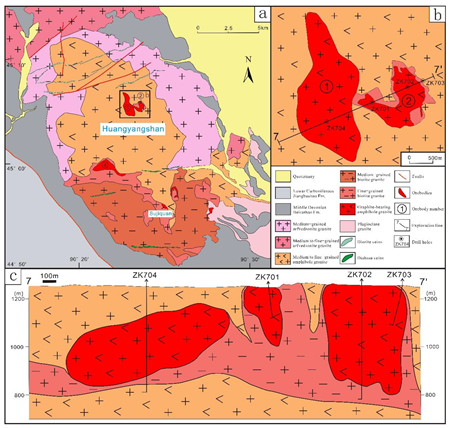
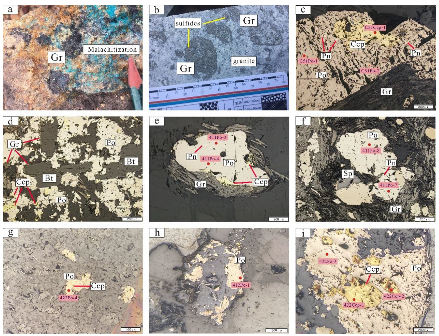
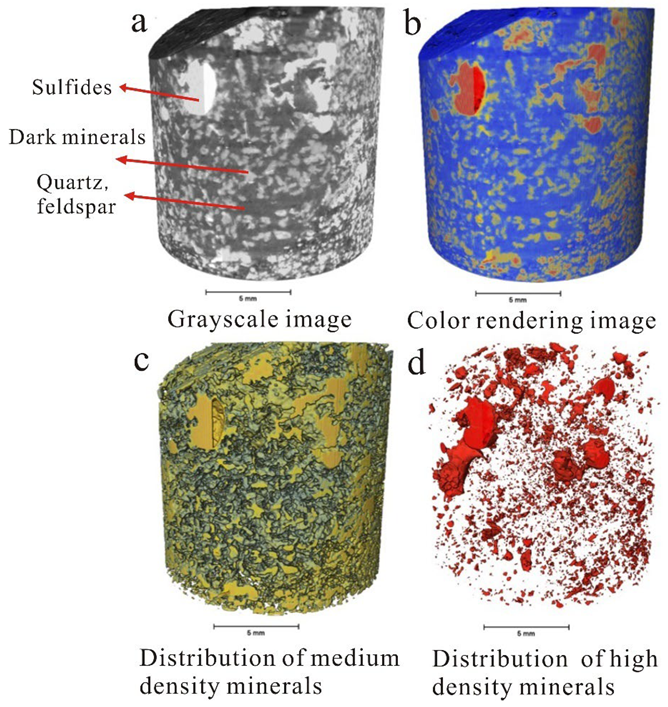
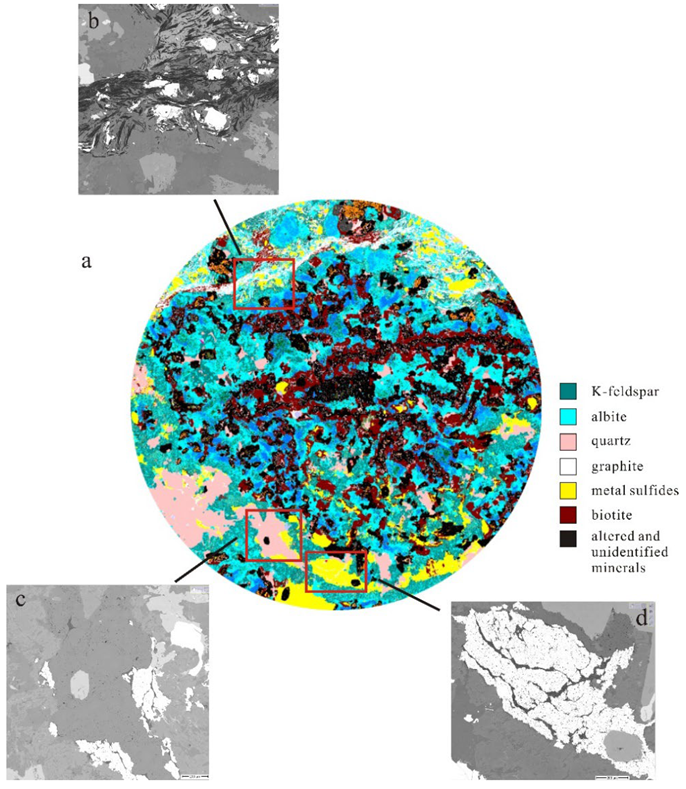
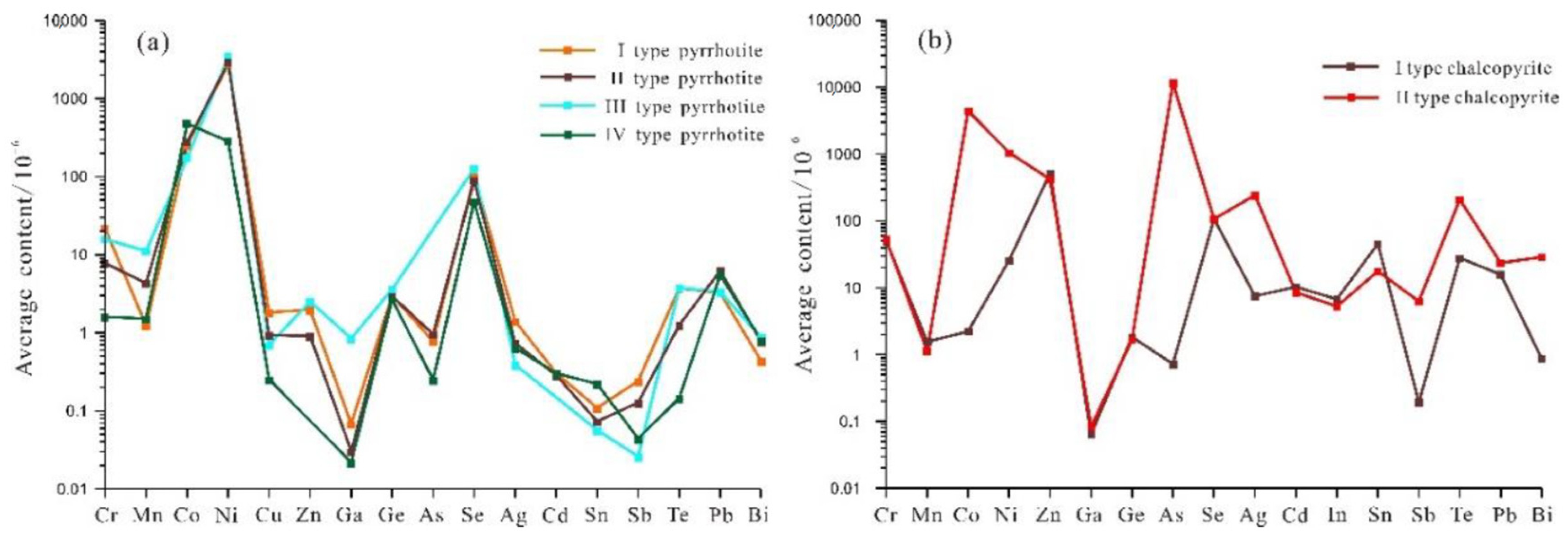
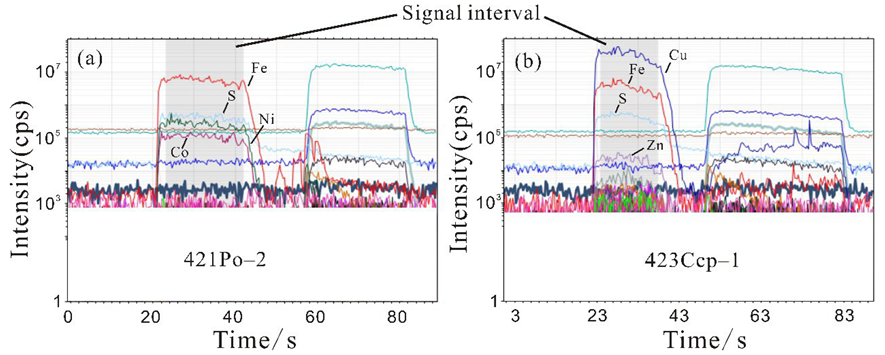
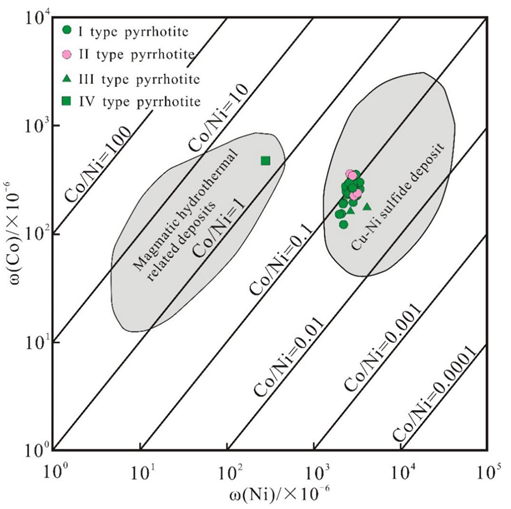
| Minerals | Area Fraction (%) | Mass Fraction (%) |
|---|---|---|
| Albite | 19.53 | 21.62 |
| K-feldspar | 12.29 | 13.39 |
| Graphite | 11.82 | 8.55 |
| Dark minerals (mainly biotite) | 11.09 | 14.26 |
| Quartz | 10.78 | 12.02 |
| Sulfide | 6.47 | 12.67 |
| Oligoclase, andesine | 7.98 | 9.41 |
| Altered and unidentified minerals | 14.58 | 8.07 |
| Number | Type | Cr | Mn | Co | Ni | Cu | Zn | Ga | Ge | As | Se | Ag | Cd | Sn | Sb | Te | Pb | Bi |
|---|---|---|---|---|---|---|---|---|---|---|---|---|---|---|---|---|---|---|
| 422Po-1 | type I yellow pyrrhotite | 2.14 | 1.31 | 357 | 3109 | / | 0.69 | / | 4.36 | / | 117.02 | 0.5 | / | 0.07 | / | 1.81 | 1.72 | 0.29 |
| 412Po-2 | 2.02 | 0.15 | 336 | 2764 | 0.34 | 0.83 | / | 3.24 | 0.68 | 86.13 | 0.66 | 0.09 | 0.16 | 0.03 | / | 3.1 | 1.15 | |
| 433Po-2 | 3.23 | 1.25 | 232 | 2482 | 0.27 | 1.64 | 0.03 | 2.64 | 0.04 | 100.04 | 0.57 | 0.01 | 0.12 | 0.14 | 1.07 | 0.81 | 0.19 | |
| 423Po-2 | 1.78 | 0.34 | 227 | 3178 | 0.11 | / | 0.03 | 2.07 | / | 92.68 | / | 0.5 | 0.04 | 0.11 | 1.81 | 1.45 | 0.13 | |
| 423Po-10 | 7.76 | 0.46 | 243 | 3172 | 0.3 | 1.07 | 0 | 2.23 | 0.41 | 80.59 | 0.3 | 0.54 | / | / | 0.5 | 1.72 | 0.19 | |
| 423Po-13 | 75.07 | 0.76 | 238 | 3216 | 1.85 | 2.96 | / | 1.59 | 0.27 | 97.3 | 0.63 | 0.14 | / | / | 1.33 | 1.71 | 0.46 | |
| 411Po-3 | 154.43 | 1.21 | 292 | 2534 | 0.85 | 2.07 | / | 3.76 | / | 122.89 | 0.42 | 0.26 | 0.07 | 0.61 | 0.25 | 0.36 | 0.06 | |
| 411Po-13 | 0.99 | 0.41 | 256 | 2835 | 0.77 | 0.44 | 0.04 | 4.99 | / | 101.23 | 0.2 | / | / | / | 0.59 | 1.83 | 0.16 | |
| 421Po-1 | 2.86 | 0.68 | 261 | 3466 | 0.5 | 0.44 | 0.03 | 3.96 | 0.41 | 100.24 | 0.42 | / | / | / | / | 0.85 | / | |
| 421Po-7 | 173.15 | 0.46 | 224 | 2987 | 4.5 | 1.21 | / | 3.25 | 0.81 | 106.22 | 0.03 | / | 0.11 | / | 2.21 | 1.26 | 0.11 | |
| 423Po-1 | 3.75 | 0.03 | 197 | 2885 | 0.11 | / | / | 2.53 | / | 95.01 | 0.09 | / | 0.23 | 0.02 | 0.06 | 2.2 | 0.4 | |
| ZK43Po-1 | 0.19 | 0.37 | 249 | 2398 | 0.71 | 3.57 | / | 3.77 | 0.73 | 94.34 | 1.77 | / | 0.05 | / | 4.46 | 4.81 | 0.71 | |
| 411Po-4 | 1.53 | 0.21 | 276 | 2356 | 0.31 | 1.69 | 0.04 | 2.99 | / | 101.06 | 0.2 | 0.42 | / | / | 1 | 0.6 | 0.34 | |
| 411Po-11 | 70.53 | 4.9 | 281 | 3065 | 16.94 | / | 0.01 | 4.47 | 1.76 | 66.44 | 2.09 | / | / | / | / | 1.72 | 0.22 | |
| 422Po-3 | 0.39 | 0.83 | 288 | 2962 | 0.25 | / | 0.07 | 2.23 | 0.26 | 108.56 | 0.3 | 0.09 | / | / | 0.31 | 0.78 | / | |
| 421Po-2 | 2.49 | 0.47 | 302 | 3448 | 0.6 | 1.04 | 0 | 2.7 | 0.04 | 109.55 | 0.23 | / | / | / | 0.68 | 0.79 | 0.25 | |
| 421Po-8 | 71.84 | / | 285 | 2910 | 0.15 | 3.5 | / | 2.95 | 0.99 | 83.3 | / | 0.25 | 0.03 | / | / | 0.86 | 0.14 | |
| 433Po-1 | 4.31 | 0.83 | 239 | 2562 | 1.12 | 0.3 | / | 2.93 | 0.17 | 103.54 | 0.07 | 0.21 | / | 0.13 | 1.18 | 0.09 | 0.08 | |
| 423Po-3 | 0.8 | 0.81 | 257 | 2964 | 0.8 | 0.5 | 0.04 | 1.57 | 0.51 | 129.47 | / | 0.1 | 0.04 | 0.15 | / | 0.97 | 0.08 | |
| ZK43Po-2 | 4.42 | 0.84 | 298 | 2883 | 2.37 | / | / | 3.05 | / | 100.09 | 2.34 | / | / | / | 10.03 | 11.59 | 0.76 | |
| ZK45Po-1 | 12.37 | / | 155 | 2117 | / | / | 0.02 | 3.39 | 1.45 | 89.63 | 0.12 | 0.12 | 0.13 | 0.25 | 2.15 | 0.91 | 0.38 | |
| ZK45Po-2 | 1.57 | 2.06 | 123 | 2240 | 1.24 | / | / | 2.88 | 1.72 | 81.89 | 1.03 | 0.64 | 0.32 | 5.77 | 3.77 | 0.53 | ||
| 423Po-4 | 1.28 | 0.9 | 247 | 3014 | 0.55 | / | 0.09 | 2.16 | / | 105.27 | 0.21 | / | 0.09 | 0.02 | / | 1.79 | 0.15 | |
| ZK41Po-2 | 4.69 | 0.4 | 195 | 2241 | 1.54 | 0.96 | / | 2.89 | 2.17 | 102.89 | 0.15 | 0.46 | 0.03 | / | 2.66 | 1.22 | 0.36 | |
| 411Po-7 | 0.29 | 0.23 | 338 | 2779 | 2.52 | / | 0.09 | 2.28 | / | 89.7 | 1.47 | / | / | / | 10.17 | 10.93 | 1 | |
| C51Po-1 | type I yellow pyrrhotite | 1.89 | 0.27 | 191 | 2215 | 2.9 | / | 0 | 3.61 | / | 100.88 | 21.57 | 0.56 | 0.17 | 0.02 | 20.6 | 7.91 | 0.5 |
| C51Po-2 | 13.66 | 11.18 | 153 | 1998 | 6.6 | 11.21 | 0.25 | / | 100.6 | 0.36 | 0.33 | 0.04 | 1.09 | 2.1 | 4.9 | 0.64 | ||
| 411Po-9 | 11.2 | 2.19 | 265 | 2707 | 0.89 | / | 0.38 | 2.93 | / | 112.86 | 0.12 | 0.46 | 0.25 | / | / | 1.21 | 0.39 | |
| 421Po-3 | 0.74 | 0.03 | 262 | 2807 | 0.11 | 1.5 | 0.05 | 2.67 | / | 106.63 | 0.67 | / | 0.03 | 0.31 | 15.6 | 22.91 | 2.05 | |
| average | 21.77 | 1.24 | 251 | 2769 | 1.82 | 1.98 | 0.07 | 3 | 0.78 | 99.52 | 1.4 | 0.3 | 0.11 | 0.24 | 3.92 | 3.27 | 0.43 | |
| 411Po-8 | type II brown pyrrhotite | 14.09 | 0.08 | 298 | 2595 | 0.73 | 1.2 | 0.06 | 3.71 | / | 83.71 | 0.27 | / | 0.02 | / | / | 0.79 | 0.33 |
| 412Po-5 | 0.35 | 0.06 | 362 | 2662 | / | 0.58 | / | 2.7 | / | 101.11 | 0.49 | 0.03 | / | 0.07 | 0.7 | 0.37 | 0.14 | |
| 422Po-2 | 23.07 | / | 348 | 2852 | 0.96 | 0.73 | 0.03 | 3.2 | 1.33 | 98.18 | / | 0.37 | 0.02 | 0.05 | 2.37 | 0.53 | 0.05 | |
| 423Po-7 | 3.08 | 0.24 | 237 | 2991 | 0.68 | 1.93 | / | 2.66 | 0.98 | 102.85 | 0.43 | / | 0.12 | 0.05 | 0.45 | 4.08 | 0.54 | |
| 423Po-8 | 6.34 | 24.7 | 225 | 2944 | / | / | / | 3.11 | 0.37 | 85.22 | 0.35 | 0.1 | 0.12 | / | / | 15.02 | 1.45 | |
| 423Po-9 | 4.2 | 0.31 | 227 | 2946 | 2.23 | 0.95 | / | 2.81 | 1.21 | 79.99 | 2.04 | / | 0.12 | 0.34 | 1.62 | 24.45 | 2.9 | |
| 423Po-11 | 3.6 | 3.87 | 240 | 3233 | 0.08 | 0.09 | / | 2.65 | / | 87.59 | / | / | 0.04 | 0.2 | / | 1.23 | 0.26 | |
| 423Po-12 | / | 0.87 | 267 | 2852 | / | / | 0 | 2.77 | 0.89 | 74.03 | 0.85 | 0.65 | / | 0.04 | 1.12 | 3.39 | 0.51 | |
| average | 7.82 | 4.3 | 275 | 2884 | 0.94 | 0.91 | 0.03 | 2.95 | 0.96 | 89.09 | 0.74 | 0.29 | 0.07 | 0.13 | 1.25 | 6.23 | 0.77 | |
| 422Po-4 | type III Pyrrhotitein fine-grained core | 6.67 | 17.94 | 181 | 4173 | 1.03 | 2.52 | 0.85 | 4.03 | / | 130 | 0.13 | / | 0.06 | / | 0.78 | 4.33 | 0.6 |
| 422Po-5 | 25.04 | 4.48 | 166 | 2691 | 0.37 | / | / | 3.16 | / | 124 | 0.65 | / | / | 0.03 | 6.8 | 2.33 | 1.15 | |
| average | 15.85 | 11.21 | 174 | 3432 | 0.7 | 2.52 | 0.85 | 3.6 | / | 127 | 0.39 | / | 0.06 | 0.03 | 3.79 | 3.33 | 0.87 | |
| 412Po-1 | type IV | 1.61 | 1.52 | 480 | 283 | 0.25 | / | 0.02 | 2.66 | 0.25 | 47.58 | 0.64 | 0.3 | 0.22 | 0.04 | 0.15 | 5.49 | 0.81 |
| Number | Type | Cr | Mn | Co | Ni | Zn | Ga | Ge | As | Se | Ag | Cd | In | Sn | Sb | Te | Pb | Bi |
|---|---|---|---|---|---|---|---|---|---|---|---|---|---|---|---|---|---|---|
| 411Ccp-1 | type I copper yellow chalcopyrite | 29.08 | / | 1.73 | 32.92 | 323 | 0.13 | 2.58 | 1.41 | 133.85 | 2.77 | 6.71 | 12.61 | 115.79 | / | 3.93 | 1.01 | 0.12 |
| 422Ccp-1 | 60.68 | 0.07 | 1.74 | 8.66 | 363 | 0.08 | 1.24 | / | 95.69 | 3.23 | 6.48 | 4.96 | 7.82 | / | / | 1.16 | 0.03 | |
| 421Ccp-1 | 336.9 | / | 0.81 | 6.46 | 680 | 0.01 | 2.15 | 0.22 | 78.79 | 15.46 | 10.03 | 5.59 | 2.58 | / | 15.82 | 15.77 | 0.75 | |
| 423Ccp-1 | 7.49 | 0.34 | 3.63 | 14.93 | 559 | / | 1.19 | / | 95 | 8.39 | 9.46 | 5.04 | 25.26 | 0.02 | 37.66 | 48.72 | 0.82 | |
| 423Ccp-2 | 5.48 | / | 1.4 | 9.14 | 528 | 0.04 | 2.31 | / | 108.36 | 8.81 | 10.5 | 5.93 | 8.68 | 0.2 | 7.58 | 3.63 | 0.22 | |
| 423Ccp-4 | 5 | 0.15 | 1.8 | 22.12 | 725 | / | 1.66 | / | 133.34 | 3.95 | 13.93 | 5.76 | 6.06 | / | 7.19 | 27.99 | 0.23 | |
| ZK46Ccp-1 | 13.87 | 9.36 | 1.63 | 13.5 | 445 | 0.09 | 1.81 | / | 93.15 | 6.84 | 9.71 | 7.43 | 36.2 | 0.38 | 36.2 | 8.67 | 1.98 | |
| ZK46Ccp-1 | 13.72 | 0.44 | 6 | 69.66 | 581 | 0.05 | 2.21 | / | 133.24 | 11.17 | 17.34 | 7.71 | 46.54 | 0.17 | 58.19 | 13.63 | 2.05 | |
| C51Ccp-1 | 0.53 | 0.21 | 1.85 | 43.26 | 546 | 0.07 | 2.34 | / | 124.52 | 7.79 | 10.31 | 5.85 | 87.3 | / | 54.98 | 11.72 | 1.03 | |
| 411Ccp-2 | 27.87 | 0.34 | 1.74 | 35.8 | 453 | 0.03 | 0.93 | 0.53 | 75.63 | 6.53 | 8.44 | 6.5 | 117.85 | / | 29.24 | 25.51 | 1.45 | |
| average | 50.06 | 1.56 | 2.23 | 25.64 | 520 | 0.06 | 1.84 | 0.72 | 107.16 | 7.49 | 10.29 | 6.74 | 45.41 | 0.19 | 27.87 | 15.78 | 0.87 | |
| 422Ccp-4 | type II brown chalcopyrite | 50.43 | 0.56 | 4881 | 1098 | 435 | 0.08 | 0.87 | 10,784 | 83 | 266 | 7.99 | 4.74 | 17 | 7.05 | 203 | 24.06 | 31.47 |
| 422Ccp-5 | 57.89 | / | 4352 | 1138 | 465 | 0.05 | 2.51 | 12,572 | 116 | 244 | 9.37 | 5.1 | 18.91 | 6.1 | 213 | 22.96 | 29.11 | |
| 412Ccp-1 | 51.02 | 1.68 | 4084 | 923 | 355 | 0.12 | 1.63 | 11,490 | 121 | 217 | 8.24 | 5.94 | 17.1 | 5.63 | 210 | 23.65 | 26.12 | |
| average | 53.11 | 1.12 | 4439 | 1053 | 419 | 0.08 | 1.67 | 11,615 | 107 | 242 | 8.53 | 5.26 | 17.67 | 6.26 | 209 | 23.56 | 28.9 |
Publisher’s Note: MDPI stays neutral with regard to jurisdictional claims in published maps and institutional affiliations. |
© 2022 by the authors. Licensee MDPI, Basel, Switzerland. This article is an open access article distributed under the terms and conditions of the Creative Commons Attribution (CC BY) license (https://creativecommons.org/licenses/by/4.0/).
Share and Cite
Ren, Y.; Li, J.; Sun, X.; Li, Z.; Sun, Z. Genesis of Metal Sulfides and Its Significance on Graphite Mineralization in the Huangyangshan Graphite Deposit, East Junggar, Xinjiang Province, China. Minerals 2022, 12, 1450. https://doi.org/10.3390/min12111450
Ren Y, Li J, Sun X, Li Z, Sun Z. Genesis of Metal Sulfides and Its Significance on Graphite Mineralization in the Huangyangshan Graphite Deposit, East Junggar, Xinjiang Province, China. Minerals. 2022; 12(11):1450. https://doi.org/10.3390/min12111450
Chicago/Turabian StyleRen, Yunsheng, Jingmou Li, Xinhao Sun, Zuowu Li, and Zhenjun Sun. 2022. "Genesis of Metal Sulfides and Its Significance on Graphite Mineralization in the Huangyangshan Graphite Deposit, East Junggar, Xinjiang Province, China" Minerals 12, no. 11: 1450. https://doi.org/10.3390/min12111450





